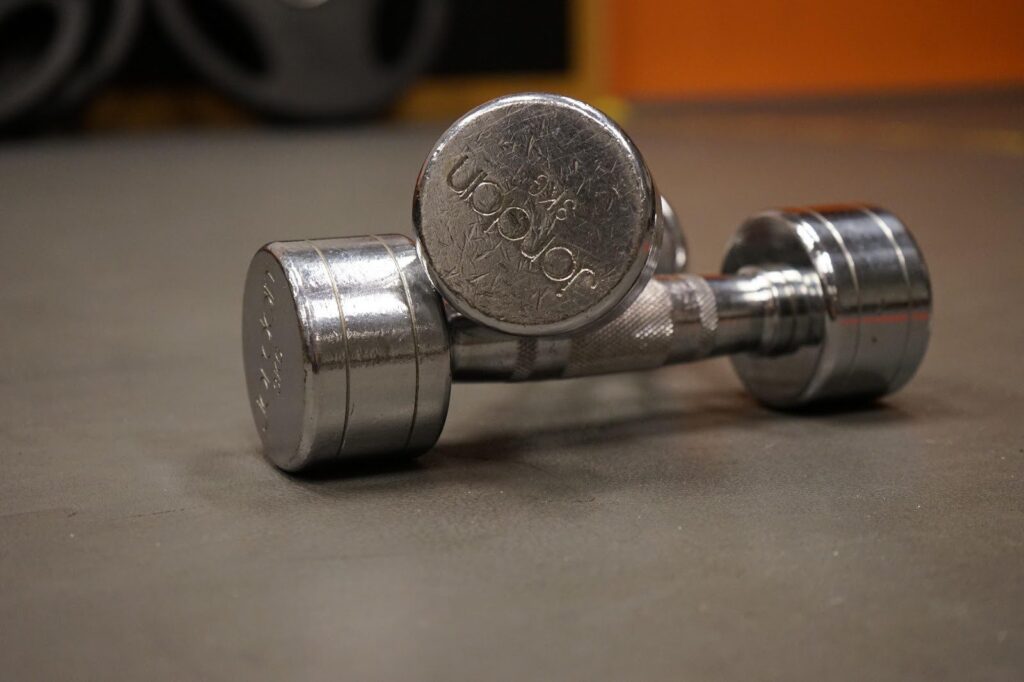You’re struggling to maintain your muscle and you’re arms and legs keep getting flabbier.
Lifting the groceries, the kids or the grand kids is getting harder and harder to do.
You never imagined losing your strength and having to rely on others to do your heavy lifting.
What if you were trapped or fell and needed to get yourself out of an emergency situation? Could you do it with your weakness?
It’s not too late to preserve your muscle. You can reserve and build muscle muscle at any age.
Strength training to maintain or build your muscle is easy to do once you set a routine.
But how did you get to this state in the first place?
What Happens As We Age
Did you know that you lose about 7 pounds of muscle mass every 10 years?
You could lose 3 to 5 percent of your muscle mass each decade!
It’s a myth that once your muscle mass starts to decline, there’s nothing you can do.
You can regenerate your muscle mass by strength training properly.
Going to the gym and putting huge plates on barbells is way too much.
You need to increase your weights with strength training over time, in order to gain muscle mass.
But Weights Make You Bulky!
The average person is not going to be spending multiple hours a day in the gym getting ripped and bulky like the professional weight lifters you’re thinking about.
Ladies listen up – you are not going to bulk up from lifting weights!
That idea is a myth. It’s not the way the body works.
The only way that happens is if you’re in the gym for hours and hours every day and you’re actively working to accomplish that goal.
What Causes Muscle Wasting
The technical term for a loss of muscle, otherwise known as muscle wasting, is sarcopenia.
If you are stressed, not working out and eating terribly – you are muscle wasting.
You’re more likely to be muscle wasting if you’re in your mid-30s to 50s.
Perhaps you’ve noticed that you can’t put on muscle or maintain it, even though you are working out daily.
The problem is that you are doing all the wrong workouts.
Likely you are spending too much time on the cardio machines and not enough lifting weights.
You can find out if you’re muscle wasting by assessing the organic acid metabolites in your urine; this is an organic acid test.
With this test, you can see what’s happening with your muscles and your metabolism.
It also tells you how well you’re breaking down proteins, fats, and carbohydrates.
Organic acids testing shows you how your habits and sedentary lifestyle are affecting your health.
Inactivity
One of the greatest causes of muscle wasting is inactivity.
If you stop working out for as little as 10 days, your body starts loses muscle and metabolism slows.
This is why it is important to make sure that you are as active as you can possibly be.
Losing muscle mass ruins your metabolism.
The more muscle mass you have, the faster you burn calories, and the better you balance your blood sugar.
Muscles take up glucose, the sugars that you eat, from the bloodstream faster than other tissues.
Muscles store sugars as something known as glycogen, to be used later for energy.
If you aren’t using the glycogen in your muscles, because you are aren’t moving enough during the day, you’re body will store extra sugars as fat.
Stress
The next big factor is stress. The more stressed out you are, the more your blood sugar skyrockets and stores those sugars as fats.
There is a connection between high stress levels and muscle wasting as workouts are often skipped when stressed out.
One of the best ways to manage stress is to workout.
Weightlifting has a huge effect on stress management and mood.
Weightlifting, just like running and other exercises, can help with release of serotonin, dopamine, and endorphins.
A research study from the University of South Carolina found that women who were put on a twice weekly program of weight training had a 60 percent decrease in their anxiety levels in only 6 weeks!
Since stress and anxiety go hand in hand – strength training serves both purposes.
What Happens When You Lift Weights
When you put a weights in your hands and put tension on your muscles, the muscle tension signals to your brain that this muscle is going to be used more.
If that muscle is going to be used more, the body reacts by making the muscle stronger.
Blood flow increases and growth hormones are released.
Growth hormones will trigger the connections of the muscle to move more protein so that more protein filaments are created.
It’s the protein filaments that increase, not your muscle cells. You’re born with all the muscle cells you’re ever going to have.
The proteins infiltrate your muscle cells, allowing them to contract more and allow for more tension (weight) to be placed on that muscle.
If you continue lifting weights for at least 6 weeks, your body starts to create more mitochondria in your muscle cells.
Mitochondria are the little factories that make energy.
Research has shown that it takes 3 weeks of consistent weightlifting to stimulate your muscle to increase mitochondria.
The body does this based on the amount of weight you’re putting on the muscle.
The more weight you put on that muscle, the more the body will respond. The more you can increase the weight, the better that muscle is going to adapt.
Bone Density
With strength training you’re also going to see that connections from the tendon to the bone become stronger.
Anthropologists are able to look at skeletons and determine what that person did for a living based on the connections of the tendons to the bone.
Your body lays down more bone when you lift weights.
The best way to maintain bone density is by lifting weights. This also applies to your joint health. If your muscles are stronger around the joints, your joints will be healthier.
Nervous System
Every muscle in your body sends messages to the brain up your spinal cord.
The more you work out, the more nervous system connections are used and maintained by your body.
Strength training helps you strengthen and coordinate your nervous system.
If you put a weight in your right hand, the left side of your brain processes the information.
You can see change in your coordination as early as 2 to 8 weeks after starting a weight training program.
Use It or Lose It
It only takes 14 days to lose muscle through inactivity. The good news is that your body responds quickly to rebuild muscle.
Once your muscles are getting a regular workout, you’re going to have more caloric burn. Your metabolism is going to get faster. You’re going to use more glucose for energy versus store it.
Plus with strength training you’ll get more oxygen to your muscles and to your brain, which is going to help with moods too.
The benefits of strength training compound on themselves and encourage you to keep lifting.
How to Get Started
Before embarking on a new strength training program, I highly recommend that you have a functional movement assessment.
Don’t jump in with too much too soon without knowing the weaknesses in your body that need to be strengthened.
Not addressing your muscle imbalances and weaknesses can lead to serious injury and prolonged recovery time.
It is worth your time to see a sports-specific physical therapist who understands the motion of the body and can help you identify the discrepancies in terms of your muscles.
The next step is to assess your digestion and nutrient intake.
Do you have gas, diarrhea, bloating, or constipation?
What is happening in the poo department?
These are all signals for how your body is digesting the food you are eating.
So, assess yourself and then get the the organic acids test or NutrEval lab test done.
You can get these through naturopaths or functional medicine doctors in your area.
Once you get yourself digesting and you figure out what’s up with your body, you definitely need a multivitamin.
Look for a multivitamin that has vitamin B1, B2, B3, B6 and B12. The B vitamins are critical for making energy.
Vitamin D helps your muscles work better.
Fish oil helps to increase muscle mass because it’s going to help with decreasing inflammation and boosting protein metabolism in your mitochondria.
The next big thing is protein. It’s possible your not eating enough protein because you’re too busy eating junky carbs.
Track your protein intake and see where you’re at. You should be getting 75 to 80 grams of protein a day as a baseline.
What Are You Waiting For?
It’s not too late to strengthen up your muscles to get rid of those flabby arms and legs.
Imagine having the strength to lift groceries, the kids and finally stop asking for help with lifting heavier things.
How amazing would it feel to feel strong enough to fend for yourself it this world.
Stop fretting about not getting results at the gym because you’re hitting the cardio a too much and skipping out on the weight training.
Get into your local gym and get started on your path to becoming fit and strong, so you can resist the majority of the problems that come with aging.
You got this – what are you waiting for?
If you enjoyed this blog post, I have a podcast dedicated to this exact subject.
Click HERE to listen into the podcast.
youtube





